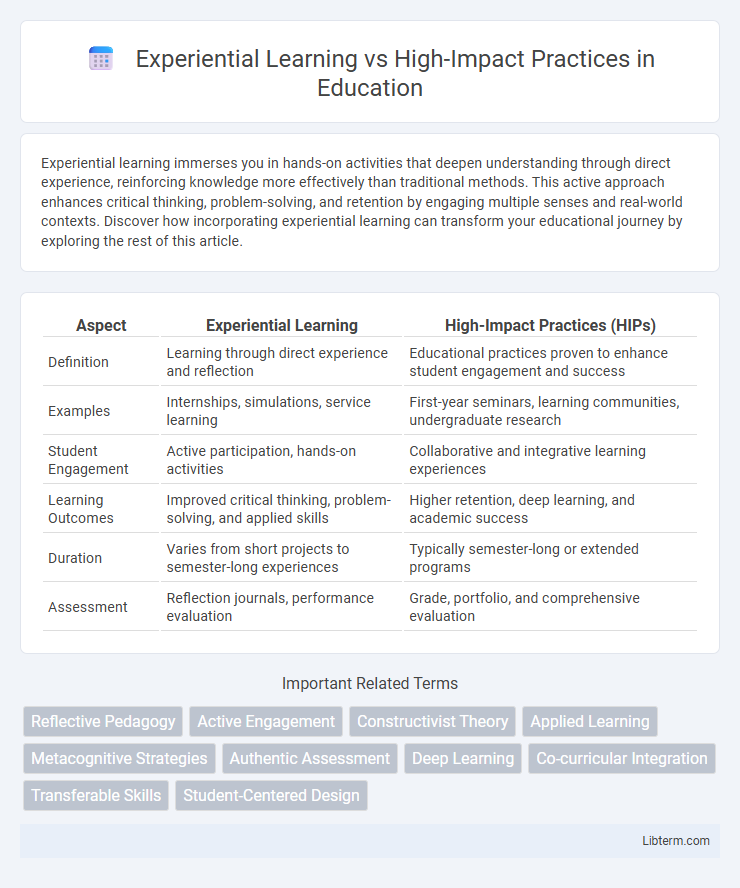Experiential learning immerses you in hands-on activities that deepen understanding through direct experience, reinforcing knowledge more effectively than traditional methods. This active approach enhances critical thinking, problem-solving, and retention by engaging multiple senses and real-world contexts. Discover how incorporating experiential learning can transform your educational journey by exploring the rest of this article.
Table of Comparison
| Aspect | Experiential Learning | High-Impact Practices (HIPs) |
|---|---|---|
| Definition | Learning through direct experience and reflection | Educational practices proven to enhance student engagement and success |
| Examples | Internships, simulations, service learning | First-year seminars, learning communities, undergraduate research |
| Student Engagement | Active participation, hands-on activities | Collaborative and integrative learning experiences |
| Learning Outcomes | Improved critical thinking, problem-solving, and applied skills | Higher retention, deep learning, and academic success |
| Duration | Varies from short projects to semester-long experiences | Typically semester-long or extended programs |
| Assessment | Reflection journals, performance evaluation | Grade, portfolio, and comprehensive evaluation |
Understanding Experiential Learning
Experiential learning involves active participation where learners engage directly with real-world tasks, fostering deeper comprehension and critical thinking skills. This approach emphasizes reflection on concrete experiences, enabling students to connect theory with practice for enhanced knowledge retention. High-impact practices often incorporate experiential learning elements, amplifying their effectiveness through immersive and collaborative educational experiences.
Defining High-Impact Practices
High-Impact Practices (HIPs) are teaching and learning practices that have been empirically demonstrated to increase student engagement and improve retention, especially among historically underserved populations. These practices include service learning, undergraduate research, learning communities, internships, and capstone projects, all designed to foster deep learning and real-world application. HIPs emphasize sustained effort, meaningful interaction with faculty and peers, and opportunities for reflection, contributing significantly to student success and academic achievement.
Key Principles of Experiential Learning
Experiential Learning centers on key principles such as active engagement, reflection, and applying knowledge to real-world scenarios, fostering deeper understanding and skill development. It emphasizes learning through direct experience, iterative feedback, and critical thinking, which contrasts with High-Impact Practices that often involve structured collaborative projects or service learning. These principles enable learners to internalize concepts effectively and cultivate practical competencies essential for academic and professional success.
Core Features of High-Impact Practices
High-Impact Practices (HIPs) are characterized by sustained, intensive engagement, significant investment of time and effort, and meaningful interactions with faculty and peers, fostering deeper learning and personal development. These practices are often collaborative, involve real-world applications, and include frequent feedback, enhancing critical thinking, problem-solving, and communication skills. Experiential Learning shares some elements with HIPs but HIPs emphasize structured, high-engagement activities that consistently produce positive educational outcomes across diverse student populations.
Experiential Learning vs High-Impact Practices: A Comparative Overview
Experiential learning emphasizes hands-on, real-world experience as a core strategy for deepening student engagement and knowledge retention, often involving internships, service learning, or simulations. High-impact practices (HIPs) are a set of evidence-based teaching methods recognized for their positive effects on student outcomes, including first-year seminars, collaborative projects, and undergraduate research. Comparing the two, experiential learning can be seen as a subset of HIPs, with both aiming to enhance learning through active participation but differing in scope and specific application methods.
Benefits of Experiential Learning in Education
Experiential learning enhances student engagement by immersing learners in real-world scenarios, fostering critical thinking and problem-solving skills. This hands-on approach promotes deeper retention of knowledge and bridges the gap between theory and practice, leading to improved academic outcomes. Research shows that experiential learning boosts motivation, collaboration, and adaptability, essential competencies for success in today's dynamic job market.
Outcomes Associated with High-Impact Practices
High-impact practices (HIPs) consistently lead to improved student retention, higher academic performance, and greater engagement compared to traditional learning methods. These practices, including undergraduate research, service learning, and internships, foster deeper learning and enhance critical thinking, collaboration, and real-world problem-solving skills. Evidence shows students participating in HIPs are more likely to graduate on time and develop a stronger sense of personal and social responsibility.
Integrating Experiential Learning into Curriculum
Integrating experiential learning into the curriculum enhances student engagement by incorporating real-world projects, internships, and simulations that foster practical skills and critical thinking. High-impact practices such as collaborative assignments, service learning, and undergraduate research complement experiential learning by promoting deeper understanding and retention of knowledge. Curriculum design that strategically embeds these approaches leads to improved academic outcomes and career readiness.
Implementing High-Impact Practices Successfully
Implementing high-impact practices (HIPs) successfully requires intentional design that integrates experiential learning components such as collaborative projects, service-learning, and undergraduate research. Embedding reflection and feedback mechanisms enhances student engagement and deepens learning outcomes aligned with HIPs' goals. Institutions that provide adequate support structures and faculty development programs see higher retention and student success rates through effective HIP integration.
Choosing the Right Approach for Student Success
Experiential learning engages students through hands-on activities, fostering critical thinking and real-world problem-solving skills essential for student success. High-impact practices, such as service learning and undergraduate research, demonstrate proven effectiveness in increasing retention and deepening learning outcomes across diverse populations. Selecting the right approach depends on aligning educational goals with student needs, institutional resources, and the desired level of engagement to maximize academic achievement and personal development.
Experiential Learning Infographic

 libterm.com
libterm.com